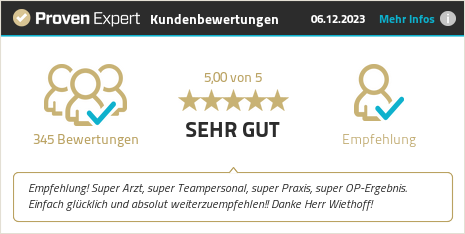ARS PEDIS
Frequently asked Questions
Our practice name is composed of the Latin words for „art“ (ars, artis) and „foot“ (pes, pedis) and is intended to mean: „Art on the foot.“
When foot surgeries are performed by experienced hands, the risk of complications falls within the lower range of what can theoretically occur with any other surgery (infection, wound healing disorders, bone healing disorders, etc.). Therefore, it is advisable to consult specialized foot surgeons (orthopedic surgeons, trauma surgeons, general surgeons, plastic surgeons).
Swelling of operated toes or the foot for a few days to weeks, sometimes even many months after the surgery, varies individually and depends on age, but it is normal. Cooling, elevating the foot, lymphatic drainage, and especially rest in the first week after the surgery counteract this.
Of course, with every foot procedure, a careful balance between risk and benefit must be considered – this applies especially to purely aesthetic procedures. For example, while small interventions for hammer toes/claw toes and toe shortening are generally extremely low risk, the indication for purely aesthetic major surgeries on the midfoot bones (so-called corrective osteotomies) should be carefully examined. Procedures performed carelessly and/or unprofessionally can, in the worst case, do more harm than good.
All operations at ARS PEDIS are performed on an outpatient basis in our own operating room. After each operation, you leave us walking and almost always without crutches. Many procedures can be performed under regional anesthesia, if desired, of course, also with light sedation or „twilight sleep.“ Our TV screen on the ceiling of the operating room can keep you entertained with Netflix and YouTube during the operation. Our anesthesiologists are available on call for procedures requiring general anesthesia.
After almost every surgery, you are allowed to leave the operating room walking, and crutches are almost never necessary. Depending on the procedure, however, you may need to wear a special shoe with a firm sole for a period of 1-6 weeks, which protects the operated area while walking (so-called postoperative shoe). Nevertheless, especially in surgeries involving bone corrections, it should be noted that the operated foot needs rest in the first few days to weeks. Cooling, elevation, rest, and lymphatic drainage contribute to rapid healing and minimize swelling of the foot.
Generally, in our practice, utmost importance is placed on minimizing or avoiding pain. You will receive finely dosed but sufficient pain medication before, during, and, of course, for the period after the surgery, so there is usually no need to worry in this regard.
Most surgeries nowadays can be carried out simultaneously on both sides without any problems. Even with conditions like Hallux valgus, large studies have shown that bilateral surgery is not associated with disadvantages for patients. The exception is larger procedures, such as Hallux valgus plus multiple hammer toes on both feet, brachymetatarsia surgeries, etc. It should also be considered that climbing stairs with two postoperative shoes may be somewhat more cumbersome than with just one. However, walking with two shoes is almost as fast (or slow) as with just one.
The consultation and the associated examination will be billed according to the GOÄ (Fee Schedule for Physicians) and cost between €30 and €100, depending on the effort involved. For purely aesthetic issues, the prescribed value-added tax is added to the fee. Almost all common surgeries are also billed according to the Fee Schedule for Physicians at regular rates. The main procedures are billed at a maximum of 3.5 times the fee, depending on the effort and medical indication (exception: Time-consuming surgeries such as the one-stage lengthening in brachymetatarsia).
The costs for medically indicated procedures are usually fully or largely reimbursed by private health insurance.
For purely aesthetic procedures, the patient must bear the costs (plus the value-added tax required for these procedures) entirely, which can range from a few hundred to several thousand euros, depending on the procedure and the extent of the operation.ARS PEDIS generally offers payment in 3 installments through the billing center PVS Nordrhein.
For longer financing, there is a cooperation with Medipay.At least for many bony misalignments, early surgery can indeed be beneficial. This is because it can help prevent long-term consequences such as arthritis due to joint misalignment, inflammation, and pain. Additionally, the general rule is that the earlier the intervention, the smaller the operation, and the faster the healing.
However:
There should be a certain level of discomfort (which, in the eyes of a plastic surgeon, can also include aesthetic considerations) because surgery remains surgery – with all its risks (see above).
In general:
If a procedure is performed under general anesthesia or with analgosedation („twilight sleep“), the person undergoing the operation should not actively participate in road traffic for 24 hours (this also applies to pedestrians, so having a companion is important).
While it is not explicitly prohibited to drive a car with a relatively bulky surgical shoe, it is not necessarily recommended for insurance reasons – especially if the right foot is affected. After major surgeries, it should also be considered that the brain subconsciously wants to protect the operated foot, potentially hindering sudden and firm braking.
For smaller operations without involvement of the midfoot bones, one can switch to supportive ballet flats shortly after the operation, making driving possible without any issues.
There are three common foot shapes:
- Egyptian foot:
The longest toe is the big toe (DI)
DI – DII – DIII – DIV – DV
Frequency: approximately 45% - Roman foot:
DI – DII – DIII – DIV – DV
The first three toes are roughly equal in length
Frequency: approximately 35% - Greek foot:
The second toe (DII) is the longest
DI – DII – DIII – DIV – DV
Frequency: approximately 20%
All surgeries at ARS PEDIS are performed on an outpatient basis. You will leave us walking and almost always without crutches after each operation. Many procedures can be performed under regional anesthesia, and if desired, also with light sedation or „twilight sleep“. Our TV screen on the ceiling of the operating room can keep you entertained with Netflix and YouTube during the operation. For surgeries requiring general anesthesia, our anesthesiologists are available on call.
Depending on the procedure and the distance from your place of residence, it is advisable to stay in Düsseldorf for one to two days after the surgery.
Hotels of various price ranges are located in the immediate vicinity of the practice, and some offer special conditions for our patients. Our practice manager will be happy to provide you with information on this.
The follow-up care either takes place here or can be handled by local colleagues (such as a surgeon, orthopedist, or general practitioner), especially if you are not from the region.
If you have any questions, our practice is always available during the day, and in urgent cases in the first few days after the operation, the surgeon can be reached 24 hours a day via a special hotline.
In addition to a personal examination and medical history here on-site, for most foot complaints, X-rays are essential for precise diagnostics. Ideally, these should be brought to the consultation but can also be taken in the immediate vicinity by a radiologist if necessary. Standard X-rays in foot surgery should be taken from top to bottom („d.p.“) and „strictly lateral“ while standing and under load. In cases of complaints in the area of the smaller toes and metatarsal bones, an oblique view can also be helpful.
A blood test („complete blood count, coagulation, electrolytes“) is also important before all surgeries performed under general anesthesia. You can have this done through your general practitioner or here in the practice.
An ECG is required by the anesthesia department only for patients with cardiac preconditions and those aged >50 years.
After bone surgeries, there is often mild to severe swelling of the toes or the entire foot, which varies greatly individually and can last for different durations. In rare cases, it may take up to a year for a foot to fully and permanently de-swell.
In addition to a gentle surgical technique, it is immensely helpful to protect the foot as much as possible in the first one to two weeks. Lymphatic drainage and compression stockings can also assist in reducing swelling.
After all medically indicated surgeries, we can issue a certificate of incapacity for work, whether you are privately insured or come to us as a self-payer with statutory health insurance.
However, in the case of purely aesthetic surgeries, the surgeon is not allowed to issue a sick leave certificate.






